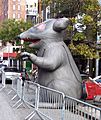Strike action facts for kids
A strike happens when a group of workers stops working. They do this to protest something and try to get better conditions. Usually, a strike is organized by a labor union. Workers might strike to get higher pay, shorter hours, or safer working conditions. Strikes became very common during the Industrial Revolution, when many people worked in factories and mines.
When workers go on strike, they often form a "picket line." This means they walk in front of their workplace. They might chant slogans and hold signs to show why they are striking. Strikers usually don't block people from entering the building. However, some people choose not to cross a picket line. They do this to show "solidarity," which means support, for the striking workers. Most unions also refuse to do business with companies that are on strike. For example, members of the Teamsters, a truck driving union, will not deliver goods to a business where workers are striking.
Contents
History of Strikes
The first known strike happened a very long time ago, around 1159 B.C., in ancient Egypt. Workers who were building tombs for Ramses III stopped working until they were treated better.
The word "strike" as we use it today comes from 1768. Sailors in London "struck" or took down the sails of their ships at the port. This stopped the ships from moving.
In 1917, the Mexican Constitution was the first to officially say that workers had the right to strike.
Different Kinds of Strikes
There are several ways workers can strike:
Wildcat Strikes
A wildcat strike is when workers strike without their labor union's official approval. These strikes might not have the same legal protections as union-approved strikes.
Sympathy Strikes
A sympathy strike happens when one group of workers strikes to support another group of workers who are already on strike. They do it to show solidarity.
Slowdown Strikes
In a slowdown strike, workers don't stop working completely. Instead, they work much more slowly than usual. This is often done when a full strike is not allowed.
Green Bans
A green ban is a type of strike where workers protest to make a company adopt more environmentally friendly practices. They want the company to be better for the planet.
Strikes and the Law
Even though an international agreement called the International Covenant on Economic, Social and Cultural Rights supports the right to strike, many countries have rules about it. Some countries do not allow workers to strike at all. Others allow it only under certain conditions.
Strikes in the United States
In the United States, people who work for the Federal Government are not allowed to strike. In some states, like New York, people who work for the state government, including teachers, also cannot strike. Workers on railroads and airlines are usually not allowed to strike, except in very specific situations.
Stopping a Strike
Sometimes, a government might try to stop a strike. They might send in the police or even the military. Just the threat of force can sometimes make workers stop their strike. This happened during the Seattle General Strike in 1919. The mayor of Seattle and the Attorney General of Washington called in thousands of marines, sailors, and police officers.
Company owners might also try to stop a strike by hiring new workers. These new workers are sometimes called "scabs" by the striking workers. Hiring new workers can be cheaper than giving in to the demands of the strikers. Strikers often yell at "scabs" as they cross the picket line. Many unions say that workers who help break a strike by crossing the picket line are not allowed to join the union. If a company is a "union shop" (meaning only union members can work there), helping to break a strike could mean a worker gets fired forever from that company.
Images for kids
-
Strike action (1879), painting by Theodor Kittelsen
-
A rally of the trade union UNISON in Oxford during a strike on 28 March 2006.
-
Teamsters, wielding pipes, clash with armed police in the streets of Minneapolis during a 1934 strike.
-
Strike in Pas-de-Calais (1906)
-
A strike leader addressing strikers in Gary, Indiana in 1919.
-
Strikebreaking driver and cart being attacked with stones during sanitation worker strike. New York City, 1911.
-
Strike breakers, Chicago Tribune strike, 1986, Chicago, Illinois
-
The charge by Ramon Casas (1899)
See also
 In Spanish: Huelga para niños
In Spanish: Huelga para niños
















